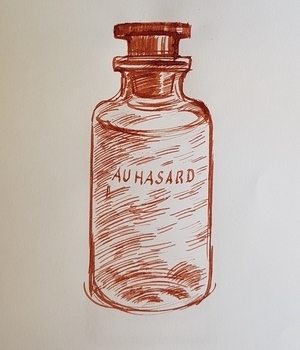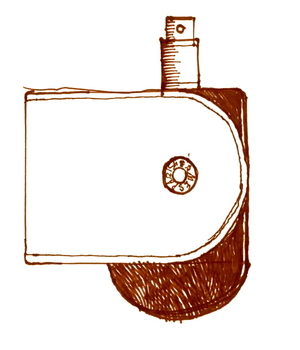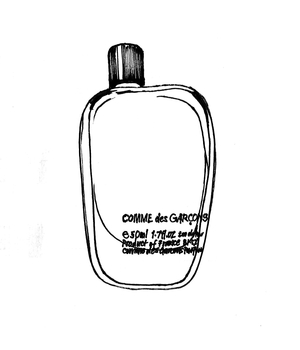Tagged With ‘Eau de Parfum’
Louis Vuitton
Au Hasard
2 July, 2018
 Almost alone among major luxury brands, Louis Vuitton did not have a single perfume to its name until 2016. That was the year when – after four years of rumours and the appointment, in 2011, of Jacques Cavallier as the company’s in-house perfumer – the company released seven scents in smart but simple bottles designed by Marc Newson. Floral and feminine in style, they were excellent examples of their kind.
Almost alone among major luxury brands, Louis Vuitton did not have a single perfume to its name until 2016. That was the year when – after four years of rumours and the appointment, in 2011, of Jacques Cavallier as the company’s in-house perfumer – the company released seven scents in smart but simple bottles designed by Marc Newson. Floral and feminine in style, they were excellent examples of their kind.
Two years on Vuitton and Cavallier have turned their attention to the male sex, with ‘Les Parfums’ for men – five new fragrances that, in their words, ‘pay homage to the adventurer on a quest for self-revelation’. Sensibly they’ve kept the same design for the bottles and packaging, with only subtle changes: each eau de parfum is a different pale colour, while the black magnetic bottle stoppers are stamped with the silver LV logo.
Sur la Route is Vuitton’s take on eau de cologne, with the evanescent but always refreshing scent of Calabrian lemon – specifically the zingy fruit and the bitter-fresh pulp around it – extended with a special grade of cedar and a touch of bergamot. The green note of freshly cut grass is balanced with the softer smell of Peruvian balsam which, Cavallier says, ‘includes the freshness of citrus and spicy notes of pink peppercorn and nutmeg’.
Orage uses the sexy, earthy smell of patchouli and pairs it with long-lasting top-quality iris, which adds a plush note of luxury to any scent. Though it’s not as stormy as its name suggests (or as woody as the press release describes it), Orage does have a hint of the green freshness that follows a summer downpour in the countryside.
L’Immensité has, perhaps, the most in common with the general run of men’s ‘sports’ fragrances such as Dior’s Sauvage, mainly because it has an overdose of the synthetic molecule Ambroxan. Some people love its mineral, slightly peppery note, but it reminds others of an electrical fire. Here, it’s framed by bitter grapefruit, ginger and labdanum.
For lovers of gourmand perfumes, there’s Nouveau Monde, which uses an extract of natural cocoa from the former French colony of Ivory Coast in combination with oud to create a rich and exotic scent with a touch of saffron underneath. Despite being an eau de parfum strength, it’s restrained rather than overpowering, like all the fragrances in the range.
My personal favourite, though, is Au Hazard, which takes another classic ingredient of men’s perfumery, sandalwood, using a sustainably cultivated variety from Sri Lanka. It’s a gentle, slightly spicy fragrance, with hints of cardamom and ambrette seeds, which would smell equally comfortable as a day or evening scent.
Hermès
Voyage d’Hermès parfum
9 May, 2015
 I wouldn’t normally suggest starting your day with a gin and tonic, but that’s exactly what the ‘pure perfume’ version of Voyage d’Hermès smells like when first you spray it on. It’s not really gin and tonic, of course, but it does share two important ingredients: alcohol (which doesn’t in itself smell of anything) and juniper, which adds its bracing, slightly bitter fragrance to both gin and Voyage d’Hermès parfum.
I wouldn’t normally suggest starting your day with a gin and tonic, but that’s exactly what the ‘pure perfume’ version of Voyage d’Hermès smells like when first you spray it on. It’s not really gin and tonic, of course, but it does share two important ingredients: alcohol (which doesn’t in itself smell of anything) and juniper, which adds its bracing, slightly bitter fragrance to both gin and Voyage d’Hermès parfum.
So why not simply spritz yourself with a glass of Gordon’s? It would certainly be cheaper, but if you smell it again after a few minutes you’ll notice that Voyage d’Hermès parfum has more to it than gin. In fact it develops into a very pleasant, slightly spicy-smelling scent, with hints of coriander and pepper and a warm, comforting woodiness underneath.
Launched in 2012, this is in-house perfumer Jean-Claude Ellena’s second take on the original Voyage from 2010, which (backed by a serious advertising budget) went on to become a big seller for the brand. While the original version is a relatively insubstantial eau de toilette – that is, the liquid in the bottle contains around 10 per cent actual perfume, diluted in odourless alcohol – this revised version is labelled as ‘parfum’, or ‘pure perfume’.
But is it? In industry jargon, to call something a ‘parfum’ generally indicates a concentration of around 40 per cent, with a punch – and a price-tag – to match. Yet Voyage d’Hermès parfum costs only around £10 more than the earlier eau-de-toilette, which seems odd. (For comparison purposes, a 50ml bottle of Chanel No5 eau-de-toilette costs about £55, while a mere 30ml of the parfum would set you back £220.) Nor does Voyage d’Hermès parfum last as long as you’d hope a ‘true’ perfume would; in fact it doesn’t even last as long as other Hermès eau-de-toilettes such as Equipage or Bel Ami, which can see you through the day.
So what’s going on? Like other online reviewers I suspect that what we have here is actually what’s known as an eau de parfum, with a concentration of between 15 and 20 per cent, which has been inadvertently mislabelled as a parfum. That’s a shame, as the world of perfume is mystifying enough without muddling up its terminology. Maybe Hermès can explain.
That gripe aside, Voyage d’Hermès parfum is an attractive, easy-to-wear fragrance, and like its predecessor it comes in a nifty bottle (in charcoal grey rather than the earlier version’s clear glass) that swivels within a protective metal case. OK, it’s a bit of a gimmick, but it’s been nicely done given the cost constraints of a mass-produced scent, and as a perfume it’s a safe choice for anyone who isn’t, perhaps, too confident about wearing anything too offbeat or eccentric. Or who simply enjoys the occasional G&T.
Comme des Garçons
Eau de Parfum
12 November, 2014
 Christmas is coming, and as a long-standing fan of over-indulgence I’m thoroughly looking forward to getting fat on Christmas pudding with brandy butter, washed down with a large glass of Harvey’s Bristol Cream, ideally in front of a roaring log fire. Alternatively I could just blow my own socks off with a generous splash of Comme des Garçons’ delicious Eau de Parfum a.k.a. Christmas in a bottle.
Christmas is coming, and as a long-standing fan of over-indulgence I’m thoroughly looking forward to getting fat on Christmas pudding with brandy butter, washed down with a large glass of Harvey’s Bristol Cream, ideally in front of a roaring log fire. Alternatively I could just blow my own socks off with a generous splash of Comme des Garçons’ delicious Eau de Parfum a.k.a. Christmas in a bottle.
Launched in 1994, this was the Japanese cult fashion brand’s first foray into perfume, but if there was nothing unusual about that, it’s rare for a first perfume to make such a big impression. Partly it was the design of the bottle, a slightly egg-shaped oval with an off-centre cap and no obvious way to stand it up.
That might sound a bit annoying, but I think it’s one of the most stylish and sophisticated perfume-bottle designs of the last 20 years. Eccentric it may be, but Comme des Garçons founder Rei Kawakubo’s design is so sleek and refined that it makes most other perfume bottles look cheap and tawdry by comparison.
The Sniff Box is about the scent, though, and what a scent this is. Created by Derby-born perfumer Mark Buxton, it’s not for the shy or faint of heart, for this is one of those fragrances that carries everything (and everyone) before you. The first thing you smell is cloves – or rather clove oil: in fact this is a distinctly oily concoction, for among the other ingredients are nutmeg oil, cinnamon-bark oil, cardamom oil, geranium oil and coriander oil. To me it even feels slightly oily on the skin, which gives it an added touch of luxury and also sets it apart from the vast majority of alcohol-based fragrances.
With ingredients like those it could hardly be anything other than spicy, but Mark Buxton cleverly added a touch of the resinous, smoky smell of incense with cedarwood, labdanum and styrax. The result is wonderfully rich and strange, and though some people find it overpowering, to be overpowered like this is like drowning in a butt of Malmsey: what a way to go!